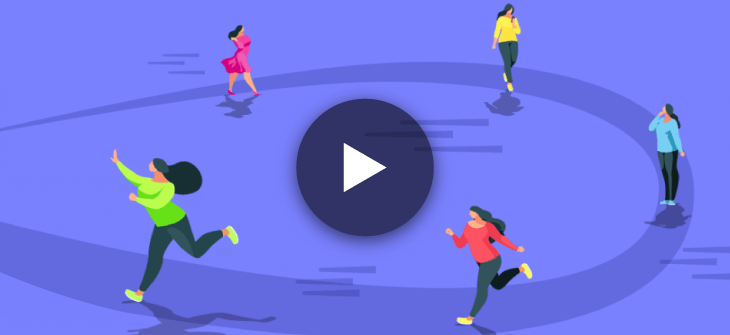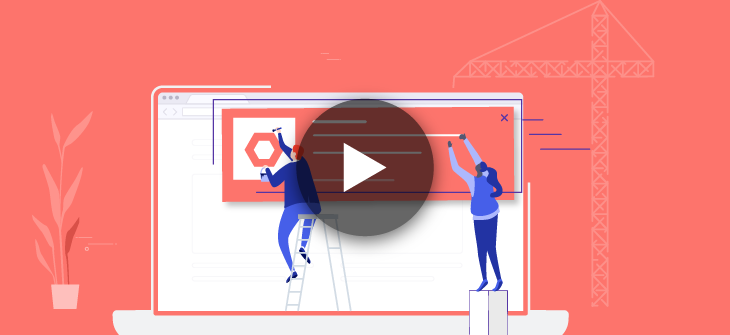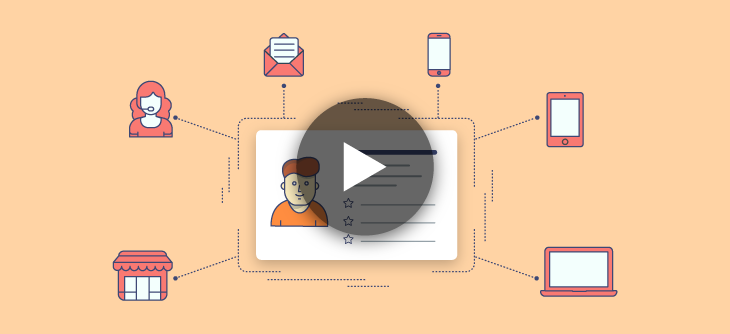Webinar Transcript
Avantika: Hello, and welcome to this webinar by WebEngage. My name is Avantika Pandey, and I am the senior content marketer at WebEngage and your moderator for today’s webinar. Before we get started, here are a few housekeeping topics. First, you will be on the listen-only mode. Second, will be recording the session, this recording will be made available to you in couple of days. Third, will have a Q&A session in the end of the webinar, but if you have any query during the session, you can put your questions in the comment box below and we’ll address them later.
Now, as most of you know, WebEngage is a marketing cloud that helps businesses engage and retain to their existing users. More than 45,000 companies are automatic…are automating their cross-channel communication across web page, mobile, email, SMS, and other digital channels with WebEngage. Now, at WebEngage, we work very closely with our clients, even after the initial set up stage. Over the years, we have realized that there is a dire need for them to upgrade the concepts in reduction marketing. You ask, why? Well, because consumers are evolving, and so are their expectations. And only way to meet their needs, and to vindicate loyalty, is by mastering the art of retention marketing.
In this webinar, our senior product specialists, Ishan Banatwala, will explain why we should change the way we approach retention marketing, and how you can achieve it with WebEngage. Over to you, Ishan.
Ishan: Thank you so much, Avantika, for all the introductions. Hey, folks, a very good afternoon. I think I’ll just first focus on the whole agenda for this particular webinar. We start with the “Retention Marketing 101”. Then we’ll focus on why consumer and businesses need the retention marketing. Followed by why you should actually stop marketing and start engaging. And then, that’s introducing WebEngage. The last part would be the Q&A session with our co-founder Avlesh Singh.
Now, what exactly is retention? Now, when you just go by the definition, it refers to the ability of a company to retain its customers over some specified period. But from what I have seen, companies still focus a lot on acquisition, and retention as a terminology is yet to be explored in its full strength. From acquisition, you can definitely increase your user base and achieve short-term goals. However, if you’re unable to retain your customers through engagement retention strategies, your profits are definitely short-lived. Now, when you talk about retention marketing, now it’s all about creating the engaged customers that return to your business to shop again. But the most important part of a customer journey is actually to get them to make the repeat purchases, right? Hence, the retention marketing is really crucial to increase your business longevity, and overall conversion rates, hereby, your business growth.
To achieve this, you need to first understand your customer journey mapping, and second, learn how to communicate with the customers at the right moments. Moving on. What exactly…why is there a dire need for the consumer businesses to actually do the retention marketing. So, when you focus on that, it’s basically to…once the customer has made their first purchase, the next intention should be to get them to either make a purchase of a higher value or make the frequent purchases. Now, the solution for that would be that several communication channels can be used to keep getting the customer back to the website or app. However, while they are on the website or app, using the appropriate modules will help not only to retain the customer but also increase the value and frequency of the purchases.
So, if you see this graph on the right-hand side, the current benchmark numbers that you can see out here, if you see this, these are the average numbers. Now, the first purchase is relatively high because you must have done a lot of acquisitions through the UDM campaigns and so many other setups for, you know, social coming and so. But when it comes to your second purchase, if you see this, it’s more…it’s literally less than half of the first purchase that you’re doing. So, this is a very big problem that actually marketers or the product guys or any other businesses currently face out here. Then it comes to your third purchase, which is obviously more low and go to the fourth purchase. Now, once the user has actually gone to the fourth purchase, it ultimately goes into your loyalty period or the loyalty program that you have.
With the data points and the personalized information, you can actually run this lifecycle campaigns and help improve your first to second order, second to third order, third to fourth order, and so on. There are multiple ways this can be achieved, off-selling, cross-selling users to increase the value of the next purchase can be one such way. Then customers may drop off either after this…their first order or after placing multiple orders. So, it is imperative for any business to engage with these customers and win them back. Solution here lies in, first, your understanding your customer’s pain points. Now, customers love to be heard and given the importance.
So, incentivize them to share their experience and give them a reason to return. Second, making high value, but inactive customers transact again is of maximum importance. When you talk about the global consumer trends, what exactly the user retention, what drives a user retention? So, if you see this, there are four metrics which actually drives your whole user retention metrics…user retention part, which is your exclusive offers, your loyalty program, you listen to feedback, your customized promotions. But if you see this, three out of the four drivers of the user retention actually need a marketing automation solution. To drive this whole thing and ultimately get the most out of this matrix that we have defined out here.
Now, in terms of the demographics that you talk about, these are…few of them, you know, average numbers in terms of what drives your highly, you know, more advanced users to the users who are just your early starters or early bloomers. When you talk about the challenges faced by marketers across industries, right? Now, one of the major challenge faced with marketers is to keep the users engaged in their whole life cycle. So, when you talk about the engagement, sending powerful and contextually relevant content at regular intervals is a key success metric.
Now, when dealing with the millions, the manual personalization becomes literally impossible, leads to higher chum rate, and your cart abandoned rate. And that definitely would answer the question, in few minds, of why having a third-party vendor, to focus on engagement retention strategies, through a marketing automation stack, and not a build an in-house solution. Now, why are…from where I’m coming from here? Lot of tech-focused companies always tend to think of building such a solution rather than having third-party vendor.
However, they have eventually turned to a full-blown automation stack like us to help them out. Primary reason, it’s not in your DNA, it’s us. You don’t want to continuously rely on your tech folks for small marketing activities. For us, we have expertise in marketing automation space, and we keep abreast to the latest trends in the market and keep adapting to it so that our end customer gets a flexible and advanced product for user engagement and retention. Now, we have won the in-house versus web engage battle at companies like Flipkart, Goibibo, Myntra, and so on, who started building a solution at their end, but eventually rolled back since they realized that idea was not scalable. And I can go on and on with so many other reasons of why not having an in-house part, and actually having a particular marketing automation stack to help you out in all your engagement retention strategies.
And I think the stats said all. If you see this out here, due to the incorrect personalization, 25% customers drop-off in the first go, and are annoyed with the brand as a whole. When you talk about the second part, 31% users uninstall the app after two to three push notifications within its week. The reason, they are all mass blast and not targeted based on the customer’s behavior. Due to waste, they receive irrelevant purchase.
Now, when you talk about the personalization part, I think I have already, you know, mentioned that how personalization and the context information sent out to the customers can help you out, right? So, if you see this, six, six, six-person marketers can’t do the personalization right now due to the lack of data or technology to send the relevant communication. So, when you talk about having an in-house ad, it’s very difficult for you to have the personalized set of communication sent out to each and every customer just on a manual basis. This is actually impossible.
Coming into the part, why you should stop marketing and start engaging? Now, I think one of the…this basically would come to the part where, you know, how to justify your marketing spends in ROI. Now, businesses struggle to justify the whole customer acquisition spends due to the low repeat purchases. Now, I’m pretty sure that the cost of acquisition is something which is obviously high, and as a marketer, you understand that. So, if you’re not able to retain your customers, ultimately that cost is going to increase again, again.
And ultimately your ROI is not gonna be that much, ultimately reducing your whole overall conversion rates, and your overall set of business profits. Having a single product, which I have seen with so many clients have already spoken and work with. And I’ve seen that most of the businesses right now do their marketing in silos, while multiple tools for email, SMS, and on-site mobile marketing. Now, the problem is, having all these things in silos creates a lot of problems when you actually want to see the analytics, when you actually want to understand how to do the whole cross-channel set communication. So, having a single product for all these things, and analytics on the top of it, is something that actually would help you out in gaining more insights and having more engagement and retention practices out there.
I think the last part, the fourth…the third part has already been covered in what I just said. And the last part is always engaged with the users on one-on-one on a large scale, which is all obviously your personalization part. Your contextual personalized message always drives your user conversion rate, your open rates, your click rates, everything. And that I’m saying with what my experience of what I have seen across the different clients. Coming to the part, why you should stack…, you know, start engaging and stack marketing with WebEngage?
When you talk about WebEngage, well, it’s basically a marketing automation cloud and which can…I mean, we can automate your whole marketing and manage your retention by optimizing all the channels. Now, what we use out here is, is the segmentation piece and the personalization piece that basically would drive your whole strategies across different channels. So, if you see this, there’s an overview of what we are all about in terms of the analytics engine, which consists of your users, segments, events, panels, cohorts, revenue, and non-stocks. When you talk about the engagement platform, we have all the channels of engagement, along with the analytics on the top of it that consists of your push notifications and ad for the app part. SMS and email, again, are your offline parts of it. On-site, which is your website overlays, which combines with your triggered set of notification, surveys, or feedback that you actually want to define, and your browser push notifications.
Now, you combine all these things together, in this cross-channel orchestration engine, or what we call it as the journey designer. It’s nothing but a whiteboard where you just create your flows based on the different behavior that the user performs. Now, what we have done for so many clients across the globe out there. And I’ll just try to focus on few of the examples out there with regards to the different industries. So, when I talk about the retail and e-commerce it’s a very subjective term, right? E-commerce means, it actually takes in all the online resources. But I’m right now focusing on basically your, you know, those set of businesses which are, you know, selling some sort of products, and that products would more or less define your more B2C set of strategies, right? So, when you talk about Flipkart, eBay, Sough.com, or even on the Chaayos part.
So, when I talk about retail, in fact for Chaayos, what we have been doing is, they have almost 98% of offline transactions going on, and only 2% contributing to the online part. So, what do we exactly do for them? We have been able to actually reduce their whole dropped cart rates, and their cross-sell transactions, even their repeat purchases just with our different set of engagement strategies that they’re using, and gaining them based on the analytics that they are able to see, right?
So, if you see this, we have been able to, on an average for all these clients, we have been able to, you know, recover almost like 20% of the drop carts, increase by 15% in the cross-sell transactions, 12% increase in the 60-day repeat purchase which, in fact, for some of the clients we already have public case studies, which will be able to see or how exactly we are able to increase that. And the kind of strategies that they have actually, you know, defined over there. And when you talk about the increase in frequency, now, your recency frequency and the monetary value, right? Now, increase in frequency basically helps you out in having more retention rate because when your customers are, again, coming on your platform repeatedly, then ultimately you have a higher chance of gaining more retention rate, and hereby more conversion rates.
The same thing that we have done for Travel/OTA/ Hospitality. There are multiple metrics that you can see out here for, in fact, for Goibibo, for Flying, for Jet Airways, and for TAJ also. Now, in fact, for the Goibibo, just using personalization, using, you know, the API level data fetching from their systems and using it for the different set of metrics has been able to increase their whole conversion rates by almost, like, 22%. And, in fact, we are contributing, I can easily flow on that, we have been able to contribute major…a lot of, you know, like, the revenue of Goibibo through WebEngage.
So, if you see this, this is the kind of things that we have been doing for so many clients in terms of the drop carts recovered, your cross-sell transactions, your succeeded repeat purchase, your increase in the frequency. Now, when you talk about the FinTech part, they…obviously the metrics will be slightly different because you are now…you are focusing on your lead generation, your nurturing, your, you know, premium payments have been paid or not based on the different kind of businesses that we are talking about.
But I think for most of the players like DSP BlackRock, and Aviva or you talk about, you know, Acko, HDFC Life, they have been literally a lot of improvement in terms of the lead generations through our on-site pieces, through our, you know, cross-channel set of communications through journeys, and multiple set of things other than that, that actually goes into it. So, in fact, there is a 10% increase in repeat purchases. So, this is all of the metrics that we have been able to, you know, do for so many clients across this different industries.
Now, when you talk about WebEngage, obviously as a client or as a prospect, you would like to understand how exactly…it’s easy to integrate with our system, right? So, rather than going into details about more of it, I would just try to focus on, you know, all your ecosystem that actually goes into it, which is your websites, mobiles, or any third-party CRM system, LMS, or your data warehouse, anything. You can just directly integrate with us through multiple strategies that we have. And they’re almost, like, six to seven ways that you can actually integrate with us and very easier ways.
And then DMP part, we basically provide it with the user profile, user behavior, device data, transaction catalog. And the whole automation engine is something that we actually goes into it where your communication engine, your personalization engine, and your segmentation engine comes into picture, and provides you with a whole multi-channel campaign orchestration which is the journeys, where you can create multiple set of campaigns based on your set of rules that you want to define, or the segmentation of the personalization that you want to define. So, this is all part of the WebEngage marketing cloud, on an overview bar.
I think more or less, this is how I don’t want to go into details about it but, yes, this is why basic 45k plus consumer businesses like WebEngage and, you know, like, this has been something that we have been doing for so many clients, and we have been changing the whole scenario in terms of the engagement retention for them. So, these are the few of the things why people actually like us more and more. In fact, we have Capital Lanes, we have, you know, the public case studies where we have been able to do so many things for our clients.
So, more or less this is what I had to say. I think that’s it for today from my side. We’ll start with the Q&A session. I think we’ll just give you a couple of minutes to time you in a question. And then ultimately we’ll start addressing the questions. Okay, we’ll start addressing the questions now. So, I think I got one of the questions which is, “I’m a part manager of a subscription service based business, is WebEngage for me?” So, it’s I think the B2B side of it.
Avlesh: Sure. Before I answer the question, my name is Avlesh. I’m a co-founder of WebEngage and it’s a privilege to be here with your guys. Thanks a bunch for attending the webinar. As well as subscription businesses go, you know, whether you are on the B2B subscription side or B2C subscription side, retention is, you know, is one of the key challenges that you need to solve. And the straight answer is that yes, WebEngage is useful for you. The modus operandi is a function of what exactly is the nature of the business? What are the renewal cycles like, and what is the ongoing engagement scenarios like? I’d be able to give you more specific answer. But at a superficial level, yes you could use WebEngage for your retention.
Ishan: Great. So, I think that should answer the question. The second question that has come here is, “What all things should I keep in mind while looking out for a marketing cloud?”
Avlesh: Okay. This is going to be a long one. You know, just a small plug here, we’re publishing a blog post and eBook very, very soon, just focused on this topic. The answer is, you know, not a simple one. But then multiple things, you know. I think the topmost criteria is what kind of a business you are. You know, B2B versus B2C, there are very different things that you need to do depending upon, you know, who is your customer. The other concentration sets, they go on from what channel of communications applies to your business.
Are the communication channels limited to email or the traditional SMS channels, you know, the text messaging channels? All your business is all poised to leverage let’s say, the new way channels like those approach. Your choices will vary. If you have mobile as a distribution strategy, if your consumers are using your mobile app, then you essentially you need to look for a multi-channel marketing automation suite, you know, which comes with its own set of nuances because you want to tie your users together across two different platforms. So, you know, as I said, the answer is not a straightforward one, you know, I haven’t named it…will have you notified when we publish our ebook, which is largely around, you know, how to choose the right tool for your…the right automation tool for your platform. I’m pretty sure you’ll find it is.
Ishan: Thank you so much, Avlesh, for explaining that. The third question that we have, the final question for now, since we are running out of time. So, this is where he is asking basically that, “I didn’t understand, these ‘Stop marketing and start engaging.’ Can you explain again?”
Avlesh: Well, that’s a, you know, that’s a thesis that, you know, that we thought would be a very nice message to spread the word around optimizing the use of retention platforms like WebEngage. What we have seen with our experience is the fact that most marketing today, whether you do retention marketing, or, you know, all you try and improve engagement, a lot of that ultimately boils down to the fact that marketers result to bulk messaging as their core modus operandi. This is like, you know, every morning somebody gets up at 9:00 a.m., composes an email and sends out to thousands and thousands of users. What we believe in WebEngage is that that, that essentially is a very flawed way of running marketing, let alone retention and engagement marketing.
And what we think is needed is a paradigm shift wherein marketers get more and more trained on how to leverage platforms like WebEngage wherein the idea is to move away from bulk messaging, to more sort of triggered communication, more of a workflow based communication, and more in the way that you start differentiating between a good user versus an average user, versus a bad user. And when you start making those distinctions, the workflows of engagement, the way you talk to your consumers, they change.
And when that changes, you know, you’ll definitely see your engagement scores going up, and you’ll see much better retention on your platform. Will write more on this. We have this thesis. We recently hosted a very nice one-day event called engagement on this. And will continue to build upon this thesis. Again, I have your name and Ishan and the team are going to send you a bunch of collateral around this. Thank you, thank you, again. I think we’re running out of time, I’m getting those signals. So, thanks everyone for attending the webinar. And I look forward to more good things.
Ishan: Thank you so much, guys. Thank you for attending this webinar. Have a good day. See you in the next one.









